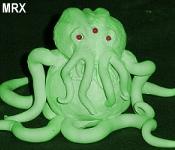
A few months ago, I had an idea to make a reversible book of shadows. What I mean by that is, it can be opened from either side (front or back). There is no distinct front and back cover. Either cover looks like it could be the front. I designed it so that one side depicts an upright pentagram and has a silver finish, and if you flip it over it depicts an inverted pentagram, and has a bronze finish.

I started with a large format blank sketch book (one of the ones I get for a song from a local discount store). I reinforced the front and back covers, along with the spine, with some chipboard. The stock cover boards that it comes with are too flimsy.
In addition to the reversible-ness of the book, I planned to experiment with a few other new techniques on this project. One new technique was the use of craft foam sheets in place of chipboard for my decorative elements. It is much easier to cut craft foam than it is to cut chipboard. Even with a sharp hobby knife, chipboard is tough, especially when cutting tight curves. If foam sheets would make a suitable replacement, I could make much more complex designs and cut them much faster.
For this book, I cut out two pentagrams, one for the back and one for the front, and eight corner bosses. I made the front corner bosses a different design than the back corner bosses. The ones that will be with the upright pentagram have a rounder style, and the ones with the inverted pentagram have a more pointed style. I worked out the designs on paper and then used spray glue to tack the paper down to a sheet of chipboard in order to make a template I know what you are thinking, I used a chip board template to avoid cutting the pieces out of chipboard. Believe me, cutting two templates out of chipboard is a lot easier than cutting eight production pieces. For the pentagrams, I just spray glued the paper directly to the foam sheet.


The other experimental technique was the covering material. After learning how to do the kraft paper and glue (or acrylic matte medium) technique for covering books, I posted about it on a few bookbinding and prop forums. However, most of those forums and some websites I looked at equated it to a similar technique that seemed to be well known on those sites. It uses Mod Podge (or white glue) and paper towels. I determined to see which gave the better results.
For this book I used Mod Podge and multi-fold paper hand towels (the kind you find in public restrooms). I ripped the towels up into quarter sheets and glued them down, letting the edges overlap.


Once the paper and Mod Podge was dry, I gave the whole thing a base coat of black acrylic paint. Then I dry brushed one cover side with silver paint and the other with an antique gold paint, which looks more bronze than gold. I finished up with a coat or two of glossy clear sealer.

Because the book was designed to be opened from either side, I couldn't use a ribbon book mark, like I usually do. The spine always stays on the left. You just flip the book over (top over bottom) and the pentagram design reverses. Theoretically, as long as you only wrote on the right hand page and never on the left, you could use this book both backwards and forwards. You could put your good spells in it with the upright pentagram facing front, and then flip it over and put your evil spells in it with the reversed pentagram facing front. Whichever kind of spells you were using would appear normal on the right hand side, and the others would appear upside down on the left hand side (until you turned it over and opened it from the correct side).


The reversible aspect was a novelty. I don't know if I will make any more of them, unless I get a good response form my customers.
As for the other experiments, I don't think I'll use either one of those again. I don't like the texture of the final product when using paper towels as a covering material. Also, Mod Podge is too expensive to use for large books like this. This book used too much of it.
As for the foam sheets, They do work, and they are easy to cut, but they remain soft and squishy after covering with the paper and glue, and that softness makes the paper more prone to tearing even under normal use. I noticed some small tears starting to form already just from shelf wear and handling. For that reason, and because I was not terribly happy with the final product, I am selling it for a lower than usual price in my shop.



















That's so cool - wow, love the metallic!
ReplyDelete